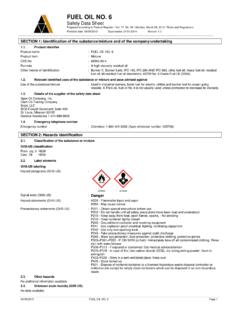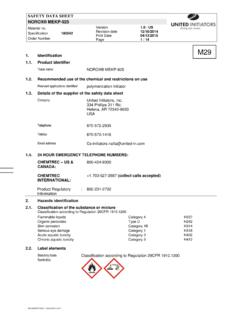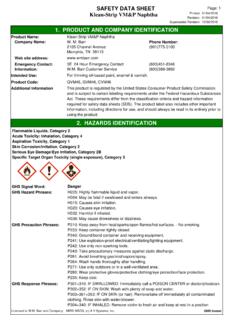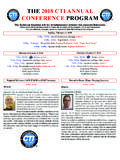Transcription of INVESTIGATION OF IMPREGNATED ACTIVATED CARBON …
1 ISSN 0104-6632 Printed in Brazil Vol. 33, No. 04, pp. 1021 - 1030, October - December, 2016 *To whom correspondence should be addressed Brazilian Journal of chemical engineering INVESTIGATION OF IMPREGNATED ACTIVATED CARBON PROPERTIES USED IN HYDROGEN SULFIDE FINE REMOVAL Isil Isik-Gulsac TUBITAK Marmara Research Center, Energy Institute, Box 21, 41470, Gebze-Kocaeli, Turkey. E-mail: (Submitted: March 10, 2015 ; Revised: August 24, 2015 ; Accepted: September 28, 2015) Abstract - The effects of relative humidity (RH), CARBON dioxide (CO2), methane (CH4), oxygen (O2) presence and gas hourly space velocity (GHSV) on H2S adsorption dynamics of KOH/CaO IMPREGNATED ACTIVATED CARBON are investigated in this study. X-ray diffraction (XRD), scanning electron microscopy with energy dispersive X-ray detector (SEM-EDX), thermogravimetric analysis (TGA), and Fourier Transform Infrared Spectroscopy (FTIR) techniques are applied and nitrogen adsorption characteristics are determined for characterization.
2 The presence of water, O2 and lower GHSV has beneficial effects on the ACTIVATED CARBON performance. CO2 decreases the adsorption capacity due to its acidic characteristics. Best adsorption capacity is obtained as 13 wt % in KOH/CaO IMPREGNATED ACTIVATED CARBON , in a CH4 (60%)/CO2 (38%)/O2 (2%) gas atmosphere, at ambient temperature, RH 90 and 5000 h-1 GHSV. Sulphur species formation was verified with the help of SEM-EDX, XRD, TGA, FTIR and nitrogen adsorption analysis on the exhausted samples. Keywords: Adsorption; ACTIVATED CARBON ; Hydrogen sulfide; Humidity. INTRODUCTION Molten carbonate fuel cells (MCFC) are high tem-perature energy conversion systems, suitable for com-bined heat and power (CHP) production. The use of renewables, such as biomass or waste-derived fuels in MCFCs is essential to reduce fossil fuel depend-ence, to enhance energy security and to support envi-ronmental sustainability.
3 Biogas is a renewable bio-fuel, which may be either landfill or anaerobic diges-tion gas. Its composition depends heavily on the feed-stock, but mainly consists of methane (CH4) (45-75%), and CARBON dioxide (CO2) (25-50%), with smaller amounts (ppm) of contaminants (hydrogen sulphide (H2S), organic sulfur, ammonia, halogen-ated hydrocarbons, and siloxanes) saturated with wa-ter vapor. These contaminants, especially H2S, de-crease the activity of the catalysts in the fuel cell electrodes, and also can cause corrosion in metallic peripheral equipments. Thus, H2S in biogas has to be reduced to the MCFC tolerance limits (< 1 ppm) (Bove and Lunghi, 2005; Ciccoli et al., 2010). Common methods for H2S removal involve bio-logical desulfurization on a filter bed (Duan et al.)
4 , 2007), NaOH/water scrubbing ( resin et al., 2014), amine-based absorption (Ohtsuka et al., 2009), ad-sorption (Seredych and Bandosz, 2007) and catalytic oxidation (Yasyerli et al., 2004). Among these meth-ods, H2S adsorption/oxidation on ACTIVATED carbons is preferred due to the lower cost of the material and the higher efficiency of the process. ACTIVATED CARBON surface properties, pore volume, surface area and chemistry determine the overall adsorption perfor-mance. In order to enhance the specific adsorption and catalytic properties, impregnation with caustics (NaOH, KOH) (Bandosz and Lee, 1998; Yan et al., 2002) and sodium and potassium carbonate (Wang et al., 2006) are studied. Temperature, gas velocity, H2S 1022 Isil Isik-Gulsac Brazilian Journal of chemical engineering concentration and gas stream humidity are known to be important parameters in the H2S adsorption pro-cess (Xiao et al.
5 , 2008). The influence of relative humidity, CO2, CH4, O2 concentration and gas hourly space velocity (GHSV) on H2S removal over the commercial KOH and CaO IMPREGNATED ACTIVATED CARBON was investigated in the present study. The ACTIVATED CARBON samples were characterized in terms of X-ray diffraction (XRD), scanning electron microscopy with energy dispersive X-ray detector (SEM-EDX), thermogravimetric anal-ysis (TGA), Fourier Transform Infrared Spectros-copy (FTIR) and nitrogen adsorption analysis before and after desulfurization tests. MATERIALS AND METHODS Materials ACTIVATED CARBON used in the adsorption experi-ments was commercial wood-based KOH/CaO im-pregnated ACTIVATED CARBON pellets. This material was specially developed by the manufacturer for biogas desulfurization through adsorption.
6 Its particle di-ameter, BET surface area and micropore volume were 4 mm, m2/g and cm3/g, respectively. Bulk density of the sample was 460 kg/m3. Experimental Apparatus The experimental apparatus shown in Figure 1 was used in the adsorption experiments. The test re-action system consisted of feeding gas system (gas cyclinders and mass flow controllers), reactor, stain-less steel impingers, hygrostat and gas analysis sys-tems. All the lines, as well as the lines from the reac-tor to the gas chromatographs, were constructed from Sulfinert materials. The temperature was measured by thermocouples placed in the reactor. The ACTIVATED CARBON granules were packed in a vertical Sulfinert fix-bed tube reactor, which was placed in a tube fur-nace. The outer and inner diameters of the tube reac-tor were mm (3/8 ) and 6 mm (~1/4 ), respec-tively.
7 For the adsorption experiments, standard H2S gas of 1000 ppm in nitrogen (certified grade ( mole % uncertainty), Air Products, Belgium) were diluted with nitrogen (ultra high purity, Haba , Tur-key). CH4 (high purity, STG, England), CO2 (high pu-rity, Haba , Turkey), and O2 (high purity, Haba , Tur-key) gases were used to simulate biogas. In order to achieve wet gas conditions, portions of N2/CO2/CH4 flows were directed to impingers, as shown in Figure 1. Relative humidity of the gases entering the reactor was measured by using a hygrostat (HST, Kimo Instruments). Permanent (N2, CO2, CH4, O2) and H2S gases were detected on-line by gas chromatographs (GC) (6890N, Agilent Technologies) with thermal conductivity detector (TCD) and flame photometric detector (FPD), respectively.
8 Analytical conditions of the gas chromatographs used in the gas composition analyses are given in Table 1. Gas samples were taken approximately every 8 min for the GC analyses. Figure 1: Schematic of the experimental set-up F: Furnace, FB: Fixed bed, GC: Gas Chromatographs, MFC: Mass flow control valves, I: Stainless steel impinger, M: Mixing manifold, NV: Needle valve, PG: Pressure gauge, TC: Thermocouple. Invest gat on of IMPREGNATED Act vated CARBON Propert es Used n Hydrogen Sulf de F ne Removal 1023 Brazilian Journal of chemical engineering Vol. 33, No. 04, pp. 1021 - 1030, October - December, 2016 Table 1: Analytical conditions of gas chromatographs used in gas composition. GC parameters Detector type TCD FPD Phase Bonded polystyrene-divinylbenzene with molecular sieve PLOT 100% Dimethylpolysiloxane WCOT Dimensions 75 m x 530 m x 40 m 105 m x mm x 5 m Oven 60 C for 8 min.
9 60 C for 3 min., 10 C/min. ramp to 180 C and hold for 5 min. Carrier Helium, psig, mL/min at 60 C Helium, psig, mL/min at 60 C Inlet temperature 94 C 150 C Detector temperature 250 C 250 C H2S Adsorption Experiments In the first part of the study, dynamic tests were carried out at ambient conditions (T= 25 C) at three different relative humidities (RH) (0%, 35%, 70%) by using 2 cm3 ( g) of ACTIVATED CARBON , with a GHSV of 15000 h-1. The experimental matrix is shown in Table 2. The hydrogen sulfide amount was kept constant at 50 ppm in the experiments. In the second part, in order to investigate the effect of gas velocity on adsorption capacity, adsorption experi-ments were performed at ambient conditions (T= 25 C) in 90% RH, by using 4 cm3 ( g) of ACTIVATED CARBON , with two different GHSVs of 5000 h-1 and 15000 h-1 in a CH4/CO2/O2 atmosphere.
10 The hydro-gen sulfide amount in the feed was kept constant at 400 ppm in the experiments. Table 3 shows the ex-perimental matrix for these experiments. In order to fulfill MCFC requirements, dynamic tests were stopped at 1 ppm outlet H2S concentration. H2S sul-fur removal capacities at 1 ppm were calculated by Equation (i) (Cui et al., 2009): ()()()6mg%mgLmg ppmmin 32000 mgmg 10 molmgcapconcsorbSSQt = = (i) where Scap (mg/mg) is the sulfur capacity, in ele-mental sulfur (mg) per gram sorbent (mg); Sconc (ppm) is total sulfur concentration in the gas mixture; Q (L/min) is the total gas flow rate sent to the reac-tor; t (min) id the breakthrough time; 32000 mg/mol is the molar weight of sulfur is; (L/mol) is the ideal gas molar volume, msorb (mg) is the mass of the ACTIVATED CARBON tested; and 106 is the conversion factor from ppm to molar concentration.
















